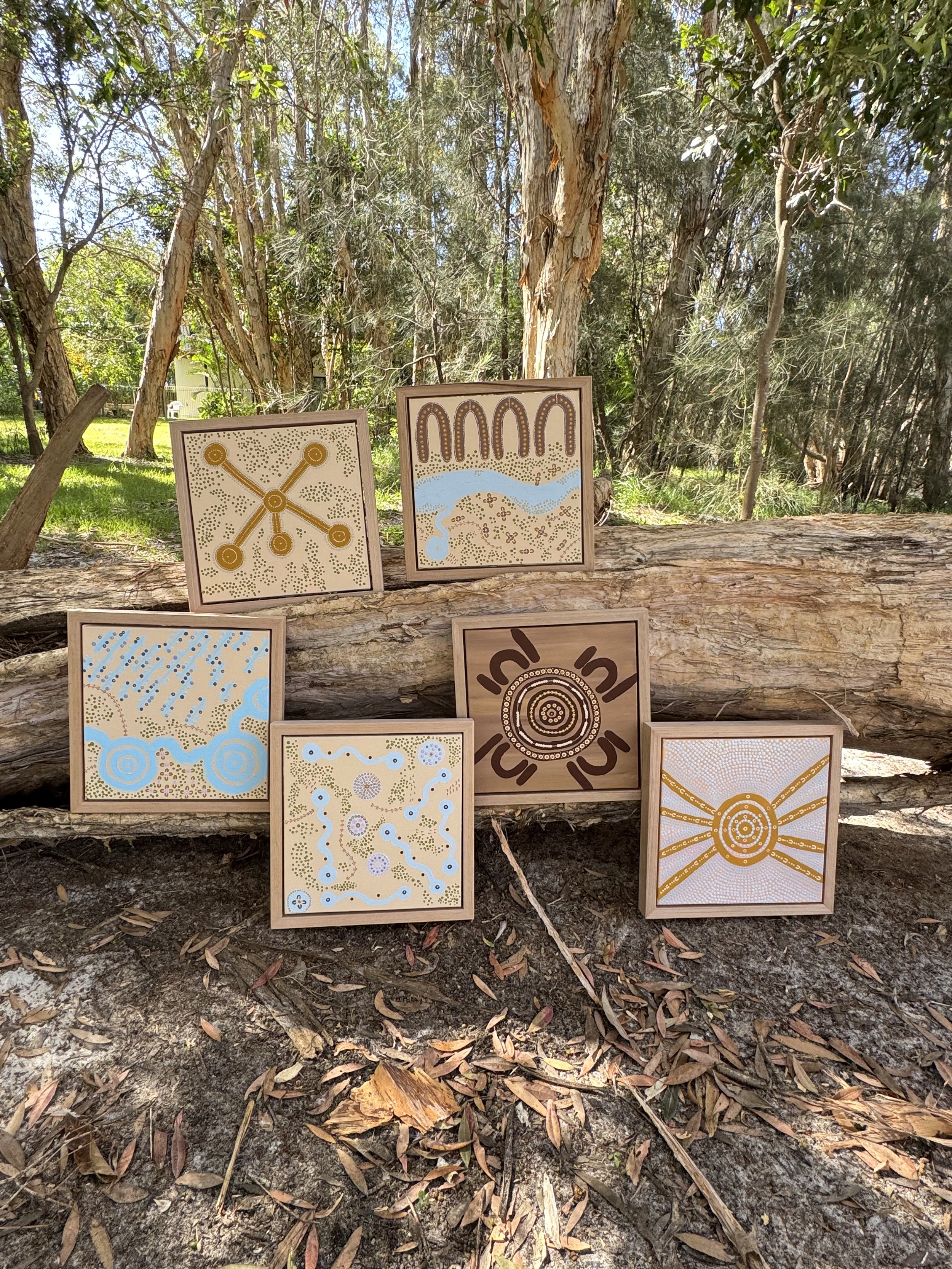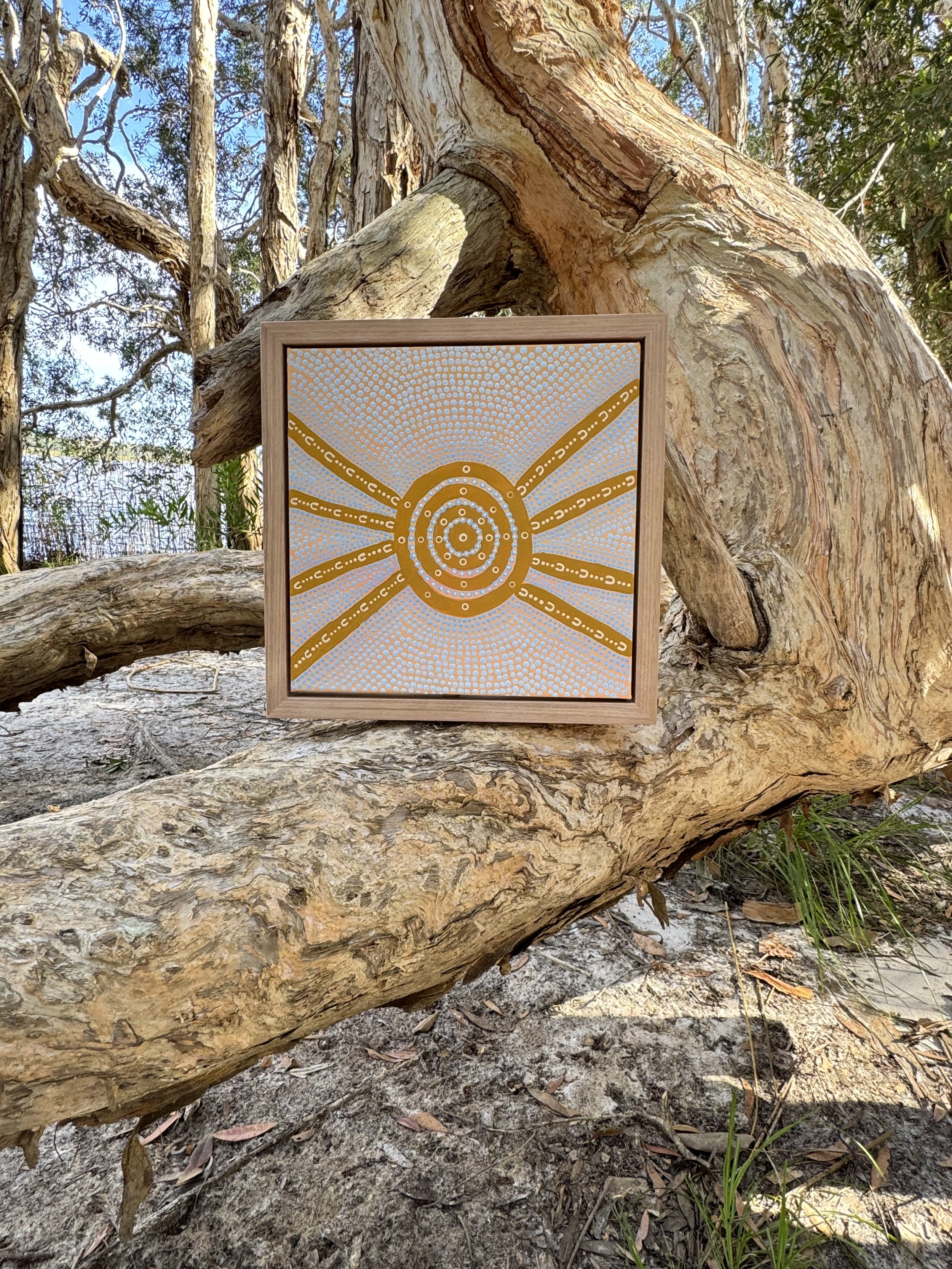 Image 1 of 3
Image 1 of 3

 Image 2 of 3
Image 2 of 3

 Image 3 of 3
Image 3 of 3




Baayay
Baayay (bi yay) Meeting place to honour, connect and reflect. Our meeting place is to come together to share our culture and our teachings, connect to our ancestors, and sit with deep meaning.
The eight straight lines connecting to the circle represent the journey in that was taken to reach the baayay. The curved arches represent the people on their way and the dots following are their tacks left behind. The blue dots surrounding the meeting place are the vibrant energy from the gathering.
Baayay—translated as "Meeting Place"—is a powerful symbol of gathering, connection, and reflection. It serves as a space for honouring the past, embracing the present, and contemplating the future. In this work, the Baayay is not just a physical location; it is a spiritual and cultural hub, where individuals come together to share knowledge, strengthen relationships, and connect with their ancestors.
At the centre, the circle represents the heart of the meeting place. This is where individuals, families, and communities converge, a space of unity, warmth, and collective wisdom. It embodies the idea of inclusivity and openness, inviting everyone to sit together, share, and listen with respect. It’s a sacred space for deep reflection, a place where one can feel connected not just to each other, but to the stories, teachings, and rituals passed down through generations.
The eight straight lines extending outward from the circle symbolise the journey in—the paths that have been travelled by those coming to the Baayay. Each line is a journey in itself, representing a person’s path to the meeting place, the experiences they have gathered, and the knowledge they bring with them. The number eight is significant, as it often symbolises infinity, continuity, and the interconnectedness of all things. These straight lines emphasie that, while each path may be unique, they all lead to the same point of convergence—the Baayay. This shared destination reflects the idea that no matter the background or the journey, all paths come together in the unity of gathering, reflection, and connection.
The curved arches emanating from the centre represent the people on their way to the meeting place. They are fluid and welcoming, symbolising the way each individual’s path is shaped by experiences, emotions, and interactions. These arches flow outward, suggesting the idea of openness and the ongoing movement of people—always in motion but always with the shared goal of coming together. The dots that trail along these arches are the tacks left behind—the marks of individuals on their journey, the footprints they leave as they walk toward this sacred meeting place. These dots reflect the ongoing passage of time, the stories that are left in each step, and the traces of those who have travelled before.
Surrounding the Baayay are blue dots, representing the vibrant energy that comes from the gathering itself. These dots symbolise the liveliness, the exchange of ideas, and the power of the collective energy that emerges when people come together to connect. The blue, often associated with calm and peace, also suggests the deep presence and flow of energy that infuses the gathering, creating an environment where reflection and sharing happen harmoniously. It speaks to the strength of community, the joy of reunion, and the peace found in shared understanding.
Together, Baayay captures a moment in time where the journeys of individuals are honoured, their stories shared, and the wisdom of ancestors is revered. It is a gathering place that transcends mere physical proximity; it is a spiritual and cultural convergence—a reminder that we are all part of a larger whole, interconnected by the experiences we share and the teachings we pass on.
Size: 350mm x 350 mm including frame
Frame: Tasmanian Oak 19mm thick, 40 mm deep
Baayay (bi yay) Meeting place to honour, connect and reflect. Our meeting place is to come together to share our culture and our teachings, connect to our ancestors, and sit with deep meaning.
The eight straight lines connecting to the circle represent the journey in that was taken to reach the baayay. The curved arches represent the people on their way and the dots following are their tacks left behind. The blue dots surrounding the meeting place are the vibrant energy from the gathering.
Baayay—translated as "Meeting Place"—is a powerful symbol of gathering, connection, and reflection. It serves as a space for honouring the past, embracing the present, and contemplating the future. In this work, the Baayay is not just a physical location; it is a spiritual and cultural hub, where individuals come together to share knowledge, strengthen relationships, and connect with their ancestors.
At the centre, the circle represents the heart of the meeting place. This is where individuals, families, and communities converge, a space of unity, warmth, and collective wisdom. It embodies the idea of inclusivity and openness, inviting everyone to sit together, share, and listen with respect. It’s a sacred space for deep reflection, a place where one can feel connected not just to each other, but to the stories, teachings, and rituals passed down through generations.
The eight straight lines extending outward from the circle symbolise the journey in—the paths that have been travelled by those coming to the Baayay. Each line is a journey in itself, representing a person’s path to the meeting place, the experiences they have gathered, and the knowledge they bring with them. The number eight is significant, as it often symbolises infinity, continuity, and the interconnectedness of all things. These straight lines emphasie that, while each path may be unique, they all lead to the same point of convergence—the Baayay. This shared destination reflects the idea that no matter the background or the journey, all paths come together in the unity of gathering, reflection, and connection.
The curved arches emanating from the centre represent the people on their way to the meeting place. They are fluid and welcoming, symbolising the way each individual’s path is shaped by experiences, emotions, and interactions. These arches flow outward, suggesting the idea of openness and the ongoing movement of people—always in motion but always with the shared goal of coming together. The dots that trail along these arches are the tacks left behind—the marks of individuals on their journey, the footprints they leave as they walk toward this sacred meeting place. These dots reflect the ongoing passage of time, the stories that are left in each step, and the traces of those who have travelled before.
Surrounding the Baayay are blue dots, representing the vibrant energy that comes from the gathering itself. These dots symbolise the liveliness, the exchange of ideas, and the power of the collective energy that emerges when people come together to connect. The blue, often associated with calm and peace, also suggests the deep presence and flow of energy that infuses the gathering, creating an environment where reflection and sharing happen harmoniously. It speaks to the strength of community, the joy of reunion, and the peace found in shared understanding.
Together, Baayay captures a moment in time where the journeys of individuals are honoured, their stories shared, and the wisdom of ancestors is revered. It is a gathering place that transcends mere physical proximity; it is a spiritual and cultural convergence—a reminder that we are all part of a larger whole, interconnected by the experiences we share and the teachings we pass on.
Size: 350mm x 350 mm including frame
Frame: Tasmanian Oak 19mm thick, 40 mm deep